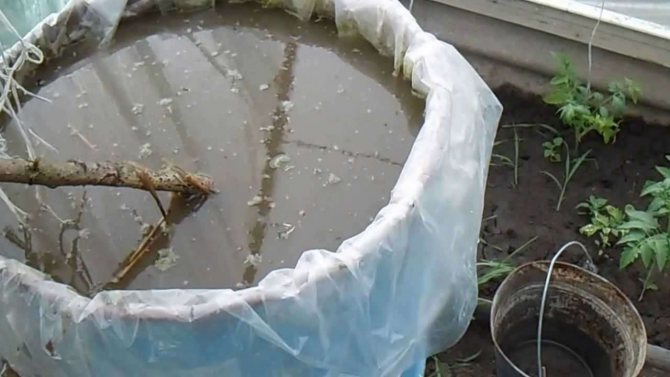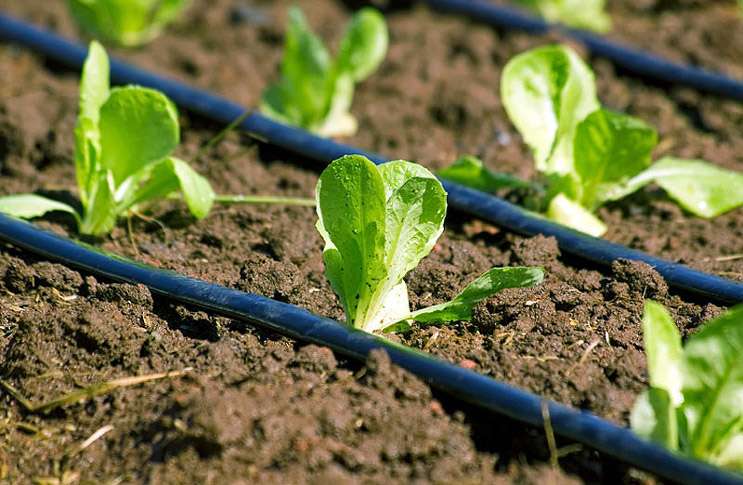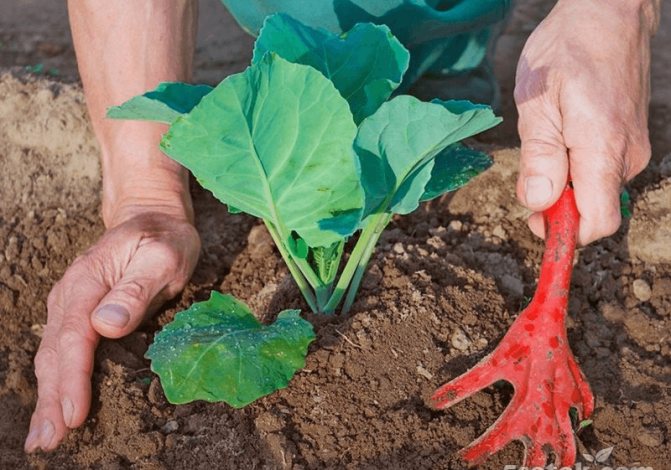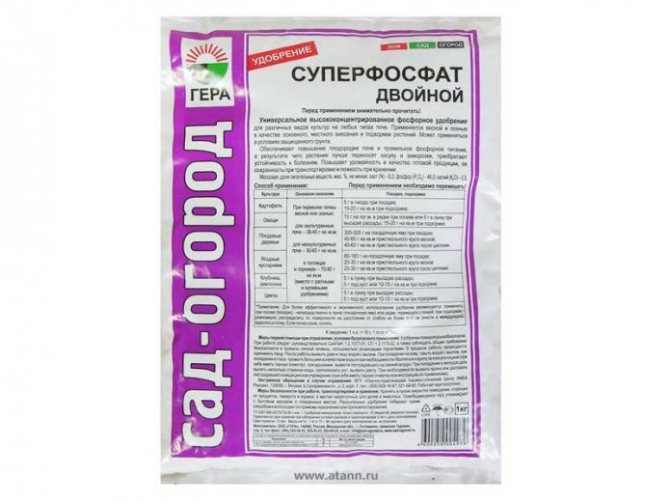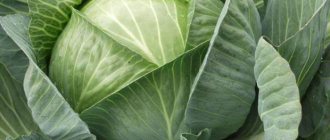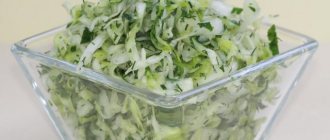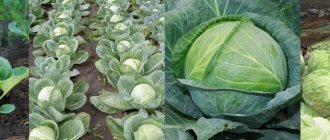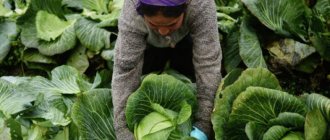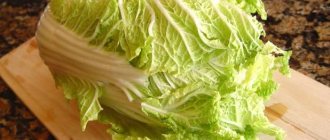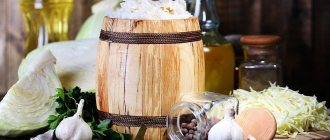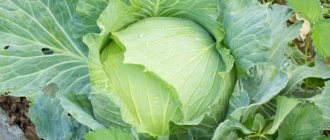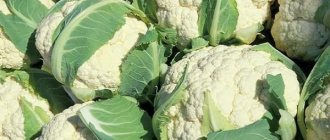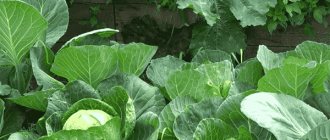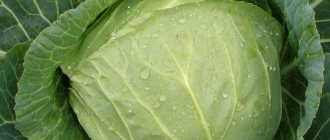Useful properties of cabbage:
White cabbage contains a large amount of vitamins and minerals. Vitamin C in the leaves of early varieties contains 20 mg%, in late-ripening - 70 mg%. Cabbage has the ability to retain vitamin C in itself for a long time. The secret of this "longevity" is that vitamin C is found in cabbage not only in its pure form, but also in a chemically bound form - "ascorbigen". Ascorbigen is the most stable form of vitamin C, and cabbage contains 50 times more of it in this form than, for example, potatoes. In general, as such, there is more vitamin C in cabbage than in potatoes, only 1.5-2 times. There is more vitamin C in cabbage than in tangerines and lemons, and 10 times more than in carrots.
In addition to other vitamins, cabbage also contains vitamins B1, B2, PP (albeit in small quantities), as well as folic, pantothenic acids, potassium, calcium, phosphorus salts, etc. White cabbage contains almost the entire set of vitamins necessary for a person.
Cabbage is a source of minerals, mainly potassium, calcium, phosphorus, sulfur. Of the trace elements, aluminum, zinc, iron, manganese prevail.
Scientists have discovered that a distinctive feature of white cabbage is vitamin U - methyl methionine, which is able to cure stomach and duodenal ulcers, ulcerative colitis, gastritis and intestinal lethargy.
The pharmacological action of cabbage is very diverse. Cabbage stimulates metabolic processes, has anti-inflammatory and analgesic effects (calorizer). It is included in a therapeutic diet for atherosclerosis (the dietary fiber contained in cabbage promotes the elimination of cholesterol, and vitamins C and P, which it is rich in, strengthen blood vessels and have an anti-sclerotic effect), coronary heart disease, gout (cabbage contains practically no purines that cause gouty deposits), gallstone disease (dietary fibers of cabbage bind and prevent the absorption of cholesterol and bile acids in the intestine, from the excess of which deposits are formed - atherosclerotic plaques on the walls of blood vessels and stones in the gallbladder), heart and kidney diseases (potassium salts contribute to the elimination of fluid), gastritis with low acidity and constipation.
Vitamins
| Vitamins | Content in 100 grams | % of the daily value |
| Vitamin PP (nicotinic acid) | 0.7 mg | 3% (you need about 20 mg of vitamin PP per day) |
| Vitamin A (Retinol) | 3 μg | 0.5% mg (Approximately 600 mg of retinol is needed per day) |
| Vitamin B9 (folic acid) | 10 mg | 2.5% (400 mg daily folate dose) |
| Vitamin E (Tocopherol) | 0.1 mg | About 1% (about 15 mg of tocopherol needed per day) |
| Vitamin C (ascorbic acid) | 45 mg | About 50% of the daily value (recommended for use at least 90 mg per day) |
Contraindications:
Why cabbage is useful - we have already figured out. But can she harm?
Compared to the beneficial properties, there is little harm here, there are some contraindications. So, overeating raw product can lead to nausea, bloating, and heaviness in the stomach.
It is not recommended to use the product with high acidity, enteritis, colitis, myocardial infarction, diarrhea.
You cannot constantly eat a raw stump, since it accumulates harmful substances that the vegetable absorbed during its growth (copper salts, nitrates, cadmium).
It is not recommended to use cabbage for thyroid diseases! Cabbage helps to cure stomach ulcers and duodenal ulcers, but in severely advanced cases and severe exacerbations, cabbage can already be harmful. The increased acidity of gastric juice also does not like cabbage, but in this case it is not contraindicated, but it should be consumed within reasonable limits and preferably not raw. Sauerkraut can be harmful to the kidneys and liver due to its high salt content, and can also harm hypertensive patients. If you really want sauerkraut, then we advise you to wash it well from the brine or initially ferment it with a minimum of salt.
When choosing cabbage, the head of cabbage should be firm and the cut should be white. If the cut is dark brown, it means that it is already stale and has lost a significant part of its useful properties. You should not buy a vegetable with stains, deep damage and foreign odors. Fresh cabbage should not have sluggish leaves; it is usually bright green and heavy in weight.
Application in dietetics and weight loss
White cabbage refers to dietary products, therefore it is very suitable for those who have cardiovascular pathology, vascular disease, liver, kidney, stomach and intestines. Dishes from it must necessarily be included in the diet of such people, because cabbage helps to improve metabolism, blood composition, thins bile, heals ulcers and enhances intestinal motility.
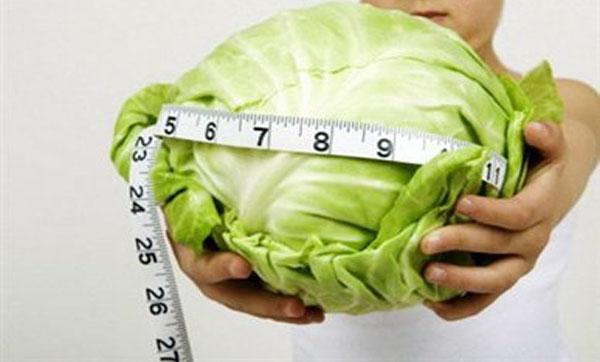
It is also useful for losing weight. Due to its low calorie content, it can be eaten by anyone who wants to lose weight: tartronic acid will not allow new fat to be deposited, and fiber will contribute to the removal of all excess from the body.
Why cabbage is useful:
For women:
Women who care about their figure need to pay special attention to this vegetable. After all, it contains tartronic acid, which does not allow the carbohydrates consumed by us to turn into fat deposits. But for many, oh, how hard it is without sweets. By the way, tartronic acid is afraid of heat treatment, but it is perfectly preserved in sauerkraut.
And cabbage also contains folic acid, which is so necessary for us, women. Cell renewal and oxygenation cannot do without it. Yes, it is irreplaceable for the skin, and for the hair. Probably everyone knows about the need for folic acid during pregnancy. But it is necessary for teenage girls (corrects puberty) and women of age.
It is unlikely that anyone is serious about the opportunity to enlarge their breasts by eating cabbage, but the fact that this vegetable contains a substance that is effective in preventing breast cancer has been proven. The substance is sulforaphane.
For men:
As for men, earlier, if their male strength weakened, potency deteriorated, ancient healers prescribed to wrap the penis with fresh cabbage leaf and keep it all night.
Speaking about the benefits of cabbage for men, one cannot but tell about sauerkraut. This popular, favorite snack, which is indispensable for Russian feasts, strengthens the immune system, increases resistance to stress. It activates metabolic processes. Moreover, it improves blood quality, lowers cholesterol and has a rejuvenating effect on the body, strengthens the heart.
Men who regularly consume sauerkraut remain energetic for many years and do not lose interest in life until old age, retain their masculine strength. Well, her brine is a unique source of vitamin C. Brine is very useful for digestion, relieves constipation, and relieves hemorrhoids.
For kids:
The list of the first complementary foods for babies, of course, consists of vegetables, but white cabbage for children under the age of one and a half years is not included in this list. The reason is trivial - a vegetable popular in our country can cause bloating, and the digestive system of babies is especially sensitive to abundant gas formation.
Nevertheless, your child's further diet will certainly contain white cabbage. In kindergartens, in the school cafeteria or in the home kitchen, this vegetable has no substitute, because not many products are available fresh all year round and without loss of taste and useful qualities. It is rich in phosphorus and potassium salts, contains a number of vitamins and minerals necessary for both a child and an adult. Nutritionists also paid attention to it: white cabbage for children with food allergies does not pose a danger, therefore, it fully meets the requirements of dietary nutrition.
Babies, as a rule, perceive cabbage dishes well. It does not burden the digestive system, cooks quickly, and has a pleasant taste.
The nutritional value
Fresh white cabbage contains 1.82 grams of proteins, 0.1 grams of fats and carbohydrates, it contains 4.48 grams. Dietary fiber is 2.1 grams, organic acids are 0.3 grams, the water content reaches 90.402 grams, starch is 0.1 grams, mono and disaccharides are 4.61 grams. All data are based on 100 grams of product.
| Content in 100 grams product | % of the daily value | |
| Protein | 1, 82 gr. | 1.8% (about 100 grams of protein is needed per day with an average weight of an adult) |
| Fats | 0.1 gr. | 0.5% (30 grams of vegetable fats are needed per day) |
| Carbohydrates | 4, 48 gr. | 1.5% (you need 400 grams of carbohydrates per day) |
What cabbage heals:
How to treat cabbage gastritis?
One of the most proven ways is to treat gastritis with cabbage juice. Most people underestimate this vegetable, but in vain. After all, white cabbage is a real chest with vitamins. In particular, it contains a unique vitamin U (methylmethionine), which is especially necessary for a person with gastritis or ulcers, as well as PP, which puts the gastrointestinal tract in order.
We can say that cabbage juice is considered some exotic, and sauerkraut is a completely familiar dish, which, however, should not be consumed in the phase of exacerbation of the disease. And in the phase of calming the disease, sauerkraut with gastritis contributes to:
- improving motor skills;
- elimination of constipation;
- improving the microflora in the intestine;
- increased immunity;
- elimination of inflammation in the mucous membrane.
And sauerkraut with gastritis with high acidity can be used to a limited extent, but only during the period of calming down of the disease. It is best to refuse it in this form when the acid level rises, so as not to cause complications of gastritis and the occurrence of stomach ulcers.
The main product in the treatment of this ailment (especially with a decrease in acidity) can be stewed cabbage. During the stewing of a vegetable, useful elements are retained, which help to improve the functioning of the digestive tract and reduce the load on non-stomach tissue. Stewed cabbage for gastritis has the following effect:
- eliminates mucosal inflammation;
- accelerates regenerative processes;
- improves digestion;
- perfectly satisfies hunger while following a strict diet;
- reduces pain.
How to eat cabbage with pancreatitis?
White cabbage in the acute phase of pancreatitis:
The inflamed pancreas quickly and violently reacts to any dietary deviations with painful attacks, increased vomiting, profuse diarrhea, renewed fever, bloating and some other serious symptoms. Dishes with white cabbage can provoke or intensify all these unpleasant signs of an acute process in the pancreas. This negative impact is due to the content in it:
- Essential oils (it is their presence that explains the pungent taste of raw cabbage);
- Coarse fiber (even with the naked eye fibers are visible in cabbage), the amount of which is 2 g per 100 g of product.
White cabbage in remission:
After the inflammation subsides or completely resolves, the diet of patients with pancreatitis expands significantly. The introduction of white cabbage begins with its inclusion in vegetable soups. If the patient does not experience any adverse changes in health after such a dinner, then other boiled, stewed and baked dishes with cabbage (casseroles, cabbage rolls, stews, cutlets, rolls, etc.) are added to the menu. While maintaining a stable satisfactory state of health, then fresh and non-acidic sauerkraut is included in the diet. However, in this form, it can serve as an impetus for a new exacerbation, so it should be eaten very carefully and in limited quantities.
Nutritional recommendations for patients with pancreatogenic diabetes (caused by pancreatitis) do not differ in this case. Indeed, little sucrose and starch are found in white cabbage, so it changes little blood sugar level.
Great video about cabbage! Worth seeing!
Trace elements
| Minerals | Content in 100 grams | % of the daily value |
| Calcium | 48.2 mg | 5% (Daily requirement 1000 mg) |
| Iron | 0.61 mg | 4% (Daily requirement 15 mg) |
| Sodium | 12.7 mg | 2% (Daily requirement 550 mg) |
| Potassium | 305 mg | 1.5% (Daily requirement 2000 mg) |
| Phosphorus | 31 mg | 4.5% (Daily requirement 700 mg) |
| Manganese | 0.16 mg | 3% (Daily requirement 5 mg) |
| Zinc | 0.43 mg | 6% (Daily requirement 7 mg) |
| Selenium | 0.3 μg | 0.5% (Daily requirement 70 mcg) |
How to treat bruises, swelling and bruising with cabbage?
The properties of cabbage leaf to heal wounds, stop bleeding are used for bruises, especially on the arms and legs. Edema and pain decrease, hematomas resolve, and the consequences of bruises are not so serious.
You can apply a clean whole cabbage leaf to the bruised area, or you can squeeze the juice out of it, moisten a piece of cotton or linen cloth with it and apply it to the damaged area, applying any fixing bandage. This lotion quickly relieves pain and repairs damaged tissue.
How to apply a cabbage leaf to sore spots?
First of all, I would like to say that it is best to take a cabbage leaf for medicinal purposes from a head of cabbage grown on your site or bought at the market from farmers and individuals. Leaves for compresses must be thoroughly rinsed with running water and dried.
If the leaves are applied to wounds or other damaged skin surfaces, then they must be doused with boiling water before use. You can prepare several leaves in this way, put them in a plastic bag, place them in the refrigerator and use them as needed.
Before use, the leaves must be kept at room temperature for a while, do not apply chilled.
Leaves must be washed before use, having previously removed the hardest parts of the veins from them. This is done in order for the leaf to let the juice out, thereby we achieve the return of all the medicinal properties of the cabbage leaf. You need to knead its outer side, which is applied to the sore spot, for which you can use a wooden hammer, a rolling pin for rolling out the dough, the blunt side of a knife. You can even cut the leaves slightly, but not through and through, so that the juice does not flow out, but only moistens the leaves.
The thickness of the compress depends on the size of the painful area, on the size and thickness of the leaves themselves. Sometimes one or two leaves are enough, and sometimes a stack of leaves may be needed, which overlap each other with a slight overlap.
Cabbage leaves should fit tightly to the sore spot and be fixed with a bandage.
Step-by-step instructions on how to grow a vegetable for the winter in the traditional way
The most common method of planting cabbage is through seedlings.We will tell you how to grow it from seeds on your own, where and how long the seedlings grow.
- Seed preparation.
Before planting, the seeds are checked for germination. To do this, they are laid out on the surface of a damp cloth, wrapped and left for 4-5 days, making sure that the fabric does not dry out. Sprouted seeds are used for planting.To protect against diseases and accelerate germination, seeds are immersed in hot water for 15 minutes, then soaked in a solution of complex fertilizer for 12 hours, washed and hardened in a refrigerator at low positive temperatures for 1 day.
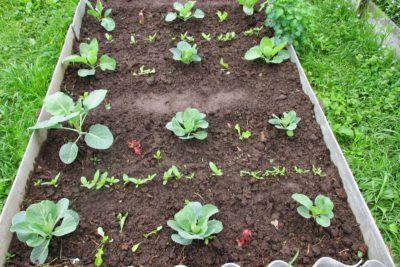

Sowing.- A soil prepared from peat, sand and sod land is poured into the prepared container in a ratio of 1: 1: 1.
Spill the surface with a solution of potassium permanganate.
- Shallow grooves are made in the ground at a distance of 3 centimeters from each other.
- Seeds are placed in the grooves at intervals of 1 centimeter.
- Sprinkle with earth on top and compact a little so that there are no voids around the seeds.
- The container is covered with glass on top and placed on the windowsill.
- Watering.
Do not allow the soil to dry out in cups with cabbage seedlings. Watering is carried out as needed, with water at room temperature. A few days before disembarking to a permanent place, watering stops. - Hardening.
2 weeks before planting the seedlings in the ground, the seedlings begin to harden with a lower temperature and sun in order to minimize stress for the plants when transplanting to a permanent place. - Top dressing.
It is recommended to carry out 2 feeding of cabbage seedlings. When two true leaves appear, foliar feeding is carried out, spraying the plants with a solution of complex fertilizer. And with the beginning of the seedling hardening period, root feeding is carried out with a solution of urea and potassium sulfate (1 tablespoon per 10 liters of water). - Landing in open ground.
Work on planting cabbage seedlings in open ground is carried out in the afternoon, when the sun is not so active. It is important to know what to add to the hole when planting. Organic fertilizer (manure or humus) and wood ash are added to the wells, well spilled with water at room temperature. The seedlings are buried to the first true leaves.Important! The center of the outlet must remain above ground level.
You can find useful information about growing cabbage outdoors here.
- Protection and care of seedlings after planting.
To protect from the bright spring sun, planting cabbage for several days is shaded with a covering material. Within a week after planting, the plants are watered twice a day.
The first shoots appear on the 4th-5th day. After the emergence of seedlings, the seedlings are transferred to a room with a temperature of about 7-8 ° C so that the seedlings do not stretch out. After another 1-2 weeks, the plants dive into separate cups, deepening to the cotyledonous leaves. At the time of planting in open ground, the seedlings should have at least 4 true leaves.
Further, a visual and informative video about planting and growing cabbage from seedlings:
Summarize
- White cabbage is an extremely healthy product.
- It contains many important nutrients and is especially rich in vitamins C and K.
- Plus, consuming this product may even help reduce your risk of certain diseases, improve digestion, and fight inflammation.
- White cabbage is a tasty and inexpensive addition to many dishes.
- The medicinal properties of cabbage make this vegetable a very important addition to your diet, which should be consumed on a regular basis.
Tags: Cabbage
- Similar posts
- Rhubarb: benefits and harms to the body
- Sweet potato (sweet potato): health benefits and harms
- 7 Impressive Health Benefits of Parsley and Its Uses
«Previous post
Caring for cabbage after planting in open ground
In order for the cabbage to give you a rich harvest, do not forget to take care of it in a timely manner.All necessary procedures are simple and familiar, but strictly required.
Watering
For the first week, I try to water the seedlings every night from a watering can with a spray, so as not to blur their roots. Cabbage is hygrophilous: non-compliance by the gardener with the irrigation schedule is destructive for it.
I water the plantings in several stages - I wait until the liquid is absorbed into the soil. I stop when the water is already "standing". The usual watering schedule is once every 5-6 days. In hot, dry weather, the plant needs to "quench its thirst" every 2-3 days.
For water procedures I choose morning time, evening time - before, after sunset, or a cloudy day. Watering is contraindicated in sunlight - you can get plant burns.
Lighting and temperature control
In the first days after transplanting, I closely monitor the plants weakened by the move. I darken from the scorching sun with newspaper or gauze. When the cabbage "gets used to it", on the contrary, it is important for a long daylight hours.
The culture does not like intense heat, drought. The best time is a slightly cool, but not rainy summer. It develops well at a temperature of 16-23 C.
Top dressing
For the full development of all varieties of cabbage, additional nutrition is required:
- The first fertilization (7-9 days from the pick). The mineral composition is introduced: 4 g of superphosphate, 2 g of potassium preparation, 2 g of ammonium nitrate per 1 liter of water. This suspension is sufficient to feed 50-60 cabbages. Water the plants abundantly before root dressing to avoid root burns.
- Second feeding (after another 14 days). The same fertilizers are applied in the same concentration. If the seedlings do not honor themselves well, feed them with an organic liquid solution: 1 part last year's manure to 10 parts water.
- The third feeding (2 days before the move). For root fertilization, use a mineral composition: 8 g of potassium preparation, 3 g of saltpeter, 5 g of superphosphate per 1 liter of water. It can be replaced with Kemira-Lux liquid solution.
After moving, the following fertilizers are shown:
- At the beginning of the development of true leaves. Mineral dressing: 10 g of nitrate per 10 liters of water. The solution is diluted for 5-6 cabbages.
- When the heads of cabbage are set. Again mineral liquid fertilizer: 8 g of potassium sulfate, 4 g of urea, 5 g of superphosphate per 10 liters. The suspension is also diluted for 5-6 cabbages.
All mineral dressings are suitable for root application. Do not forget to water the garden in front of them abundantly.
Loosening
Try to loosen the cabbage after each watering, heavy rain - gently break up the earthen crust with a hand hoe. This will give the root system access to air.
Don't forget about hilling. The first procedure - 3 weeks after the transplant, the second - after another 10 days.
Mulching
To keep moisture in the soil longer, use mulch. I usually use peat - I sprinkle it in a layer of 3-5 cm. It not only retains liquid in the substrate, but also resists the development of weeds, serves as an organic top dressing. For mulching, shredded paper, cardboard, small sawdust and tree bark, last year's humus, straw or dried cut grass are also used.
Garden care
At first after moving to a new place, the lady behaves quite modestly, even a little scared. Have pity on her: in sunny weather, protect from the scorching sun with arcs and a lightweight non-woven fabric and get drunk often. When the cabbage takes root and gets used to it, you can remove the shelter and get ready for the new whims of your guest.
Watering
First, prepare a large barrel and place it in an open area. The container will need to be regularly filled with water, and then the water heated in the sun should be carried to the cabbage bed. The trick with cold water from the hose will not work - the cabbage will not stand such bullying and will quickly get sick, adding even more trouble to you.
What difficulties can arise when growing cabbage outdoors
The main difficulty is the susceptibility of the plant to the attack of a whole horde of pests. At the same time, it is possible to cope with enemies only in safe ways - the leaves of the culture go into food, which makes the use of pesticides dangerous. However, it is possible to resist diseases and uninvited guests using eco-friendly folk methods.
Pest control
I'll tell you about the proven methods of confronting cabbage enemies:
- Slugs, fleas. Dusting young seedlings with tobacco dust.
- Aphids, caterpillars. An infusion of tomato tops is effective: 2 kg of green mass per 5 liters of water. The composition is insisted for 4 hours, then boiled over low heat for 3 hours. Cool, dilute the concentrate with water 1: 2. Then add 20-30 g of shavings of tar or household soap. The composition is sprayed with cabbage. An onion solution is also effective: a liter jar of dry husk is poured with 2 liters of boiling water. The mixture is insisted for 2 days, filtered, and another 2 liters of water are diluted. Add 1 tbsp. a spoonful of liquid soap, after which it is used for spraying.
- Cruciferous bugs. A preventive measure is the timely removal of weeds (especially those related to cabbage). Before the beginning of the ovary heads are treated with "Fosbecid", "Aktellik".
- Cabbage leaf beetle. Resist the pest by morning (dew) irrigation with an aqueous solution of tobacco dust with ash or slaked lime. Before the formation of heads of cabbage, you can use "Bankol", a 2% solution of "Actellika".
- Cabbage lurker. Prevention of the appearance of a gluttonous bug: deep digging, timely weeding, manual collection of pests. It is permissible to treat young cabbage with insecticides - "Aktellik" and "Phosbecid".
You can counteract pests by attracting natural enemies. To do this, marigolds, lemon balm, mint, and spicy plants are sown around the ridge. Jars of sweets are laid out
Disease prevention
I advise you not to hesitate with the treatment of plantings from diseases - they are developing rapidly and on a large scale. Delay in prevention sometimes threatens the death of the entire cabbage crop.
I confront the ills of culture with simple measures:
- Keela. I completely remove, destroy the affected plants. I cover their location with lime - I have not planted cabbage on this site for several more years.
- Blackleg. For prophylaxis, I process the seed before sowing in a granosan solution (about 0.4 g of substance per 100 seeds). I disinfect the soil with 50% "Tiram" - 50 g per 1 m2.
- Peronosporosis. Before sowing, I disinfect the seeds in a Planriz or Tiram solution. You can soak the seed for 20-30 minutes in water heated to 50 C. Affected plants can be treated with a 2-3% solution of "Fitosporin" before the stage of setting the head of cabbage. In the future, the disease is resisted by spraying with garlic broth.
- Rot. Preventive measures are universal: pre-sowing disinfection of seeds, compliance with the rules of crop rotation, autumn disinfection of the site for cabbage.
- Fusarium wilting. Affected seedlings are dug up, burned, and the infected soil is replaced. Disease prevention: treatment of the ridge before planting with a solution of copper sulfate (5 g of powder per 10 liters of water).
- Rhizoctonia. Fungal infection is resisted by spring treatment of the ridge for cabbage with solutions of preparations containing copper oxychloride.
Growing any kind of cabbage is a feasible business even for a novice gardener. The main thing is not to forget about timely care. Cabbage is demanding for watering, sufficient illumination. In order not to lose the harvest, do not forget to timely prevent the appearance of pests and the development of diseases.

